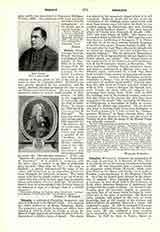

Vertot, RENEAUBERT, Sieur de, French historian, b. at Benetot, Normandy, November 25, 1655; d. in Paris, June 15, 1735. He was for some time a pupil of the Jesuit Fathers, then went to the seminary at Rouen, which he left at the end of two years to enter the Capuchin Order. His health was here greatly impaired by his austerities, and his family, alarmed, obtained permission for him to join the Premonstratensian Canons. He was afterwards appointed pastor to several small parishes in Normandy. In 1690, at the suggestion of Fontenelle and the Abbe de Saint-Pierre, he wrote his “Histoire de la conjuration de Portugal“. The book was received with favor, and in 1695 appeared the “Histoire des revolutions de Suede”. In 1703 Vertot was made a member of the “Academie des inscriptions”. Besides contributions to the “Memoires” of the Academie and other minor works, he wrote the “Revolutions romaines” (1719) and “Histoire des chevaliers hospitaliers de Saint-Jean de Jerusalem“. It is related, in connection with the latter, that in answer to an offer of additional data, he said, “Mon siege est fait”,- “My siege is finished”, a phrase misconstrued by some of his critics and interpreted as an expression of Vertot’s utter disregard for historical accuracy. The truth seems to be that he simply wished to get rid of an intruder who was trying to force upon him documents whose authenticity was very doubtful. On the other hand it must be acknowledged that Vertot’s talent as an historian is more of a literary than of a critical character.
PIERRE J. MARIQUE

